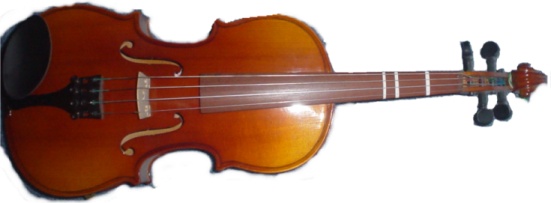There are no frets on a violin
Since there are no frets on a violin, it can be very difficult to play in tune.
If you are beginner you may cut some paper ribbons that are gently glued to the violin using a tape that can be removed again. Don't use glue, and make sure that the tape is easy to remove even after long times usage. You should only keep the ribbons on the fingerboard while you are starting. After a while your fingers will memorize the position and you don't need the ribbons any longer. Anyway the ribbons can only be used for playing in certain keys. (You could of course add more ribbons for all half tunes, but here I recommend only three ribbons for the beginner)

Where to place the ribbons
The best way to place the ribbons is if you have a tuner, or by listening to an other instrument as a piano. The position of the ribbon depends on the length of the string, but also the distance from the fingerboard to the string since the longer the distance the more tension you will put on the string. Enclosed values are theoretical calculations not including the extra string tention that you get by putting the finger on the string.
If your violin has another measure, you can multiply the free string length with the factor to the right. As mentioned the measures are approximate. The can be used for A-major on the A and E string, for D-major on the D and A string or for G- major on the G and D string. See the fingering table where to put your fingers for other scales.
| Interval | 1/1 violin (328 mm) | 3/4 violin (305 mm) | Mutiply the string length with | ||
| First finger | 36 mm | 33 mm |
|
||
| Second finger | 68 mm | 63 mm |
|
||
| Third finger | 82 mm | 77 mm |
|
The calculations are approximate and based on the tempered scale.
More ribbons
If you want to put more ribbons you may mutiply the string length with these factors to get the theoretical position of the ribbon. The intervals are relative to the loose string.
| Interval | Multiplification factor | ||
| Half tone |
|
||
| Whole tone | 0,109101282 | ||
| Minor triad | 0,159103585 | ||
| Major triad | 0,206299474 | ||
| Fourth | 0,250846462 | ||
| Tritonus | 0,292893219 | ||
| Fifth | 0,332580073 |